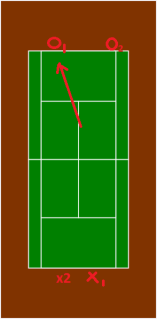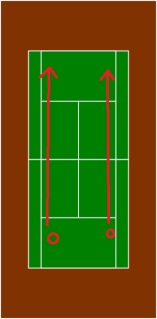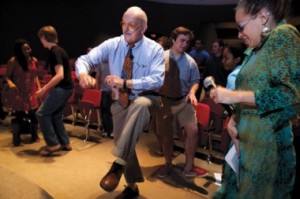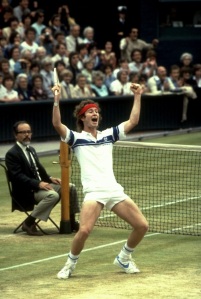1) Core Area will be about 2 feet behind the baseline , and a semi-circle around that center point into the court.
This is where you spend most of the time, and is the zone generally considered the ‘recovery zone’. So after every shot, you tend to recover to this position.
Where you recover depends on where you hit the ball.
If you hit the ball to the place marked O1, then you would recover to X1 – that is, slightly to the right of the centerline, cross-court from the ball that you just hit. The reasoning for this is that should your opponent elect to hit the ball down the line (lower percentage chance of success, more aggressive), there is a tendency for the ball to bounce on a trajectory towards the middle of the court, thus reducing the distance you have to travel. The easier, higher chance of success shot (a.k.a. higher margin shot) is the cross-court shot. This is because there is more area for you to hit the ball into, and the net is lower. So you always want to recover slightly to the crosscourt side of where you just hit the ball.
If you had just hit the ball to spot O2, then you would recover to spot X2, that is, slightly crosscourt of where you just hit the ball.
This whole area in the middle of the court is considered “no man’s land”. You either want to be on the baseline, or at the net. Anything in between is extremely dangerous and you’ll die. You’re too close in to react properly and hit groundstrokes, and you’re too far back to accurately hit volleys.
So if your opponent hits a short ball and you find yourself in this ‘no man’s land’ area, you want to hit the ball aggressively up the line and then approach the net to finish the point.
The reason you hit your approach shot up the line is because you reduce the distance you have to travel to get to the net. Unlike the baseline, you stay on the side of the court that the ball is on. This reduces the target areas for your opponent. You want to stand roughly 1 racquet length from the center line, on whatever side of the court the ball is on. The closer you are to the net, the more you cut down the angle for your opponent, but also you reduce your reaction time. You also must consider that if you touch the net with any part of your body, you lose the point. So generally you want to be 1 racquet length distant from the net when you are in volleying position.
If you hit your approach shot crosscourt, it means you have to travel a greater distance to reach the net and the opposite side of the court. It also gives your opponent more time to reach the ball. It also allows your opponent to hit their passing shot down the line, or hit their passing shot cross-court, behind the direction of your movement. So hitting approach shots down the line is the preferred tactic.
For the serve, you want to stand roughly 1 racquet length from the center T on the baseline. If you stand too far away, it makes it difficult to hit the ball up the middle, and more easy to hit the ball out wide. The opposite is true the closer you stand to the Center T.
When you are returning serve, you must recognize where your opponent is standing. If they are serving from the exact center of the court, there is little risk that they will be able to hit the ball way out wide of the court. Their most likely serve is down the center. You should adjust your position accordingly as you await their serve (r1). Vice Versa for if they are standing very far away from the center of the court. In that case you want to begin your return of serve from as wide as the doubles alley (r2).
Remember, you can always change where you stand when you are returning serve. You can move at any ponit during their serve, and although you generally begin about 1 foot behind the baseline, and 1 foot from the sideline, this is not always the case. Sometimes I return serve from inside the doubles alley. Sometimes, I stand inside the baseline. Adjusting your court positioning throws off your opponent mentally, and changes the time in which they receive the return.
Always move in as you return serve. By moving in, you reduce the angles at which the ball can bounce.
Keep your return of serve motion very compact and follow through.
This video goes over the correct recovery positions pretty clearly. The only problem is that the letters are inside the baseline. In a real game, you would obviously recover to the same positions but behind the baseline.








